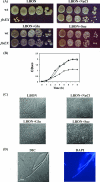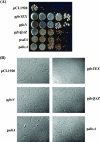Role of FtsEX in cell division of Escherichia coli: viability of ftsEX mutants is dependent on functional SufI or high osmotic strength
- PMID: 17071757
- PMCID: PMC1797223
- DOI: 10.1128/JB.01347-06
Role of FtsEX in cell division of Escherichia coli: viability of ftsEX mutants is dependent on functional SufI or high osmotic strength
Abstract
In Escherichia coli, at least 12 proteins, FtsZ, ZipA, FtsA, FtsE/X, FtsK, FtsQ, FtsL, FtsB, FtsW, FtsI, FtsN, and AmiC, are known to localize to the septal ring in an interdependent and sequential pathway to coordinate the septum formation at the midcell. The FtsEX complex is the latest recruit of this pathway, and unlike other division proteins, it is shown to be essential only on low-salt media. In this study, it is shown that ftsEX null mutations are not only salt remedial but also osmoremedial, which suggests that FtsEX may not be involved in salt transport as previously thought. Increased coexpression of cell division proteins FtsQ-FtsA-FtsZ or FtsN alone restored the growth defects of ftsEX mutants. ftsEX deletion exacerbated the defects of most of the mutants affected in Z ring localization and septal assembly; however, the ftsZ84 allele was a weak suppressor of ftsEX. The viability of ftsEX mutants in high-osmolarity conditions was shown to be dependent on the presence of a periplasmic protein, SufI, a substrate of twin-arginine translocase. In addition, SufI in multiple copies could substitute for the functions of FtsEX. Taken together, these results suggest that FtsE and FtsX are absolutely required for the process of cell division in conditions of low osmotic strength for the stability of the septal ring assembly and that, during high-osmolarity conditions, the FtsEX and SufI functions are redundant for this essential process.
Figures





Similar articles
-
A predicted ABC transporter, FtsEX, is needed for cell division in Escherichia coli.J Bacteriol. 2004 Feb;186(3):785-93. doi: 10.1128/JB.186.3.785-793.2004. J Bacteriol. 2004. PMID: 14729705 Free PMC article.
-
ATP-binding site lesions in FtsE impair cell division.J Bacteriol. 2009 Jun;191(12):3772-84. doi: 10.1128/JB.00179-09. Epub 2009 Apr 17. J Bacteriol. 2009. PMID: 19376877 Free PMC article.
-
How FtsEX localizes to the Z ring and interacts with FtsA to regulate cell division.Mol Microbiol. 2019 Sep;112(3):881-895. doi: 10.1111/mmi.14324. Epub 2019 Jun 20. Mol Microbiol. 2019. PMID: 31175681 Free PMC article.
-
Roles of FtsEX in cell division.Res Microbiol. 2019 Nov-Dec;170(8):374-380. doi: 10.1016/j.resmic.2019.07.003. Epub 2019 Aug 1. Res Microbiol. 2019. PMID: 31376483 Free PMC article. Review.
-
E. coli Cell Cycle Machinery.Subcell Biochem. 2017;84:27-65. doi: 10.1007/978-3-319-53047-5_2. Subcell Biochem. 2017. PMID: 28500522 Review.
Cited by
-
Divisome under construction: distinct domains of the small membrane protein FtsB are necessary for interaction with multiple cell division proteins.J Bacteriol. 2009 Apr;191(8):2815-25. doi: 10.1128/JB.01597-08. Epub 2009 Feb 20. J Bacteriol. 2009. PMID: 19233928 Free PMC article.
-
Synthetic growth phenotypes of Escherichia coli lacking ppGpp and transketolase A (tktA) are due to ppGpp-mediated transcriptional regulation of tktB.Mol Microbiol. 2008 Aug;69(4):882-94. doi: 10.1111/j.1365-2958.2008.06317.x. Epub 2008 Jun 4. Mol Microbiol. 2008. PMID: 18532980 Free PMC article.
-
The divisome is a self-enhancing machine in Escherichia coli and Caulobacter crescentus.Nat Commun. 2024 Sep 18;15(1):8198. doi: 10.1038/s41467-024-52217-5. Nat Commun. 2024. PMID: 39294118 Free PMC article.
-
Bacterial cytokinesis: From Z ring to divisome.Cytoskeleton (Hoboken). 2012 Oct;69(10):778-90. doi: 10.1002/cm.21054. Epub 2012 Aug 30. Cytoskeleton (Hoboken). 2012. PMID: 22888013 Free PMC article. Review.
-
Artificial septal targeting of Bacillus subtilis cell division proteins in Escherichia coli: an interspecies approach to the study of protein-protein interactions in multiprotein complexes.J Bacteriol. 2008 Sep;190(18):6048-59. doi: 10.1128/JB.00462-08. Epub 2008 Jul 11. J Bacteriol. 2008. PMID: 18621900 Free PMC article.
References
-
- Aarsman, M. E. G., A. Piette, C. Fraipont, T. M. F. Vinkenvleugel, M. Nguyen-Disteche, and T. den Blaauwen. 2005. Maturation of the Escherichia coli divisome occurs in two steps. Mol. Microbiol. 55:1631-1645. - PubMed
Publication types
MeSH terms
Substances
LinkOut - more resources
Full Text Sources
Molecular Biology Databases
Research Materials

